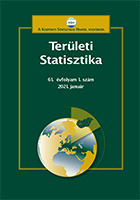Magyarország láthatatlan nemzetközi turizmusának alakulása 2010 és 2019 között
Hungary’s invisible international tourism between 2010 and 2019
Author(s): Mihály TömöriSubject(s): Social Sciences, Economy, Geography, Regional studies
Published by: Központi Statisztikai Hivatal
Keywords: hidden tourism; invisible tourism; day trips; Hungary
Summary/Abstract: The number of research projects and publications on different aspects of tourism isincreasing rapidly both internationally and in Hungary, however, the concept and related phenomena of invisible tourism (trips lasting for less than 24 hours, where in travellers’ tourism activity is unknown and/or not measured or registered in databases) have not received substantial attention up until now. Although exploring invisible tourism may cause numerous difficulties for researchers, they can apply several methods (e.g. analysis of statistical databases, measurements, observations, etc.) that may help them to draw a picture of this phenomenon. The present paper discusses Hungary’s invisible international tourism and focuses on foreigners’ day trips (trips lasting for less than24 hours) to Hungary that are not coupled with overnight stay at accommodation establishments. The study examines the phenomena of transit and cross-border excursions, but excludes foreigners’ invisiblemulti-day trips (e.g. foreigners staying at their second homes, at relatives or friends). The study is based on the analysis of the database of the HCSO (Hungarian Central Statistical Office) and introduces the number and percentage of trips corresponding to the above criteria, the expenditures related to these trips, travellers’ countries of origin and major travel motivations. Results show that Hungary’s international invisible tourism is dominated by transit visitors and shopping tourists who primarily come from Slovakia, Romania, Austria, Serbia and Ukraine. Although day trips make up for the majority of trips by foreigners to Hungary, still their economic significance is far less prominent, that is why it would be important to increase the expenditure of day-trippers by applying targeted marketing and product development as well as to increase travellers’ average length of stay.
Journal: Területi Statisztika
- Issue Year: 61/2021
- Issue No: 02
- Page Range: 170-188
- Page Count: 19
- Language: Hungarian

